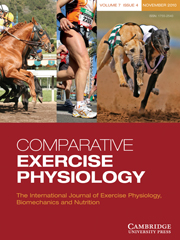Article contents
Overtraining syndrome in horses
Published online by Cambridge University Press: 01 May 2008
Abstract
Overtraining is a significant cause of poor athletic performance in both human and equine athletes. In humans, overtraining syndrome has been defined as an imbalance between training and recovery manifesting as a syndrome of chronic fatigue and poor performance that may be accompanied by physiological and psychological changes. A similar syndrome has been described in horses using both cross-sectional observations and longitudinal studies with progressively increasing training loads until signs of overtraining were observed. The original cross-sectional studies of overtraining in horses linked the syndrome to increased red cell volume. However, more recent longitudinal studies revealed that overtraining is not always associated with increased red cell volume. Once other causes of poor performance have been ruled out, overtraining syndrome should be suspected in horses with evidence of sustained decreased performance in association with one or more physiological or psychological (behavioural) signs. While no single physiological marker is able to identify the syndrome, accompanying physiological signs in horses may include a decrease in body weight, elevated heart rates during exercise, lower plasma cortisol response to exercise, or elevated muscle enzymes or gamma glutamyl transferase concentrations. Behavioural signs were consistent and an early marker of overtraining syndrome in longitudinal studies in horses, and more research on developing behavioural scores to assist in early detection of overtraining syndrome in horses -as has been achieved for humans- is warranted. Two successful models of overtraining syndrome in horses have been developed, both of which appear to meet the criteria of overtraining syndrome rather than overreaching. Overtraining syndrome in horses is real, reproducible and future research should ensure the criteria for diagnosis of overtraining syndrome are met.
Information
- Type
- Review Article
- Information
- Copyright
- Copyright © Cambridge University Press 2008
References
- 28
- Cited by

